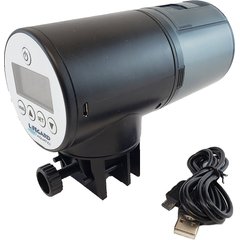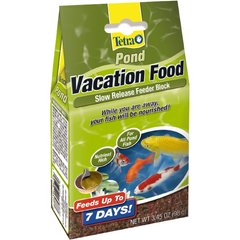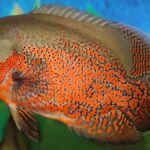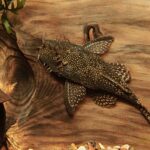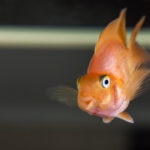How Long Can Fish Go Without Food? 5 Ways to Keep Your Underwater Friend Safe on Vacation

Photo by Chewy
If you’ve ever gone on vacation and wondered what to do with your fish, you may have wondered how long they can go without food.
Here are some simple tips to keep your fish healthy while you’re away.
Key Takeaways
- Most healthy adult fish can go 3–5 days without food. However, always consult your vet before letting your fish fast.
- Feeding needs vary by species, size, age, and water temperature.
- Automatic feeders, vacation feeders, or pet sitters can help keep fish fed while you’re away.
- Before leaving, talk to your vet about your fish’s diet and care plan to make sure they’ll be safe while you’re away.
How Long Can Fish Go Without Eating?
Feeding aquarium fish is a balancing act—too little could lead to malnutrition and too much could throw off the water chemistry in your tank.
A healthy adult fish that is fed a proper diet and kept in ideal conditions can generally go without food for three to five days without experiencing lasting consequences.
Some fish can technically go as long as 10–14 days, but fasting for this long is not recommended. Always check with your veterinarian for how long is appropriate for your individual fish.
Overfeeding is actually a bigger danger than underfeeding, according to Veronica Pardini, DVM, a certified aquatic veterinarian at Wildside Veterinary Health Center in Florida.
In fact, she says, healthy adult fish can benefit from occasionally skipping meals because it helps mimic their natural feeding patterns and gives their digestive system a break.
However, how long a fish can go without eating depends on factors such as species, size, age, and condition.
Tropical vs. Coldwater Fish
A fish’s metabolism is influenced by the surrounding water temperature, explains Robert Martinez, DVM, a certified aquatic veterinarian and owner of Aquatic Veterinary Consulting Services in Salt Lake City, Utah. That means that tropical fish inhabiting warmer waters have faster metabolisms than coldwater fish, so they need to eat more often to maintain optimal health.
For example, freshwater angelfish that thrive in water temperatures between 70–80 F may need more frequent feeding than goldfish, which prefer lower temperatures, from 50–60 F.
Small vs. Large Fish
Small fish have faster metabolisms than larger fish, so they generally need more frequent feedings. For example, tiger barbs only reach two to three inches in length and they’re very active swimmers.
During a period of fasting, tiger barbs are likely to burn through their energy stores more quickly than a larger, more sedate species like the gold severum, which grows to a minimum of six inches long.
Grazers vs. Predators
Herbivores and omnivores like blennies and goldfish, which graze on algae, plant matter, and microfauna, may require smaller, more frequent feedings than predatory fish that may go weeks between meals in the wild.
Carnivores like betta fish and oscars, despite the stark difference in their size, may be able to go longer without food than sizable herbivores like plecos.
Sick and Juvenile Fish
Juvenile fish need to be fed regularly to prevent stunted growth. When they’re still developing, Dr. Pardini cautions against fasting juvenile fish for more than 12–24 hours.
The same goes for fish that are stressed, sick, thin, or malnourished. Nutritional support is crucial during illness, and regular feedings are needed to help malnourished fish rebuild body condition.
Withholding food may also be unsafe for fish with high metabolic rates, such as certain reef fish, says Dr. Pardini. These fish can rapidly lose body condition without consistent feeding and may pass the point of recovery sooner than other species.
How To Feed Your Fish While You’re on Vacation
Consistent and balanced nutrition is crucial for keeping your fish healthy. Here are some solutions to keep your fish well-fed.
Buy an Automatic Feeder
Automatic feeders are a convenient option if your fish primarily eat dry foods (as opposed to fresh or frozen foods). They come in battery-operated or plug-in models and can be programmed to disperse measured portions of food once or multiple times a day.
Recommended Product
If you’re going to use an automatic feeder, Dr. Pardini recommends testing it for a few days so you can make any necessary adjustments before you leave. For longer absences, have a friend or sitter stop by every few days to make sure the feeder is working.
Get a Vacation Fish Feeder
If you’re only going to be gone for a few days, a vacation feeder may be sufficient to keep smaller fish fed.
A vacation feeder is a type of slow-release fish food that dissolves in water, gradually releasing food embedded in gel or a calcium block.
Recommended Product
Though convenient, vacation feeders don’t always dissolve evenly, and they may not be appropriate for large or predatory fish. Ask your vet how many calcium blocks you’ll need and where to place them.
Hire a Pet Sitter
For long absences and complex diets, a pet sitter may be the best option to keep your fish fed when you’re on vacation.
To minimize the risk of over- or underfeeding, Dr. Martinez recommends pre-portioning food in small containers or pill organizers. That way, there’s no confusion about what or how much your fish should be fed.
Use a House-Sitting Service
If your fish require multiple daily feedings or your tank has additional maintenance requirements, a house-sitting service might make the most sense.
Find a caretaker with aquarium experience, if possible, or leave detailed instructions and pre-portioned food.
Cultivate Food Sources in the Tank
For absences up to a week long, your fish may be able to go without structured feedings, but it doesn’t hurt to make natural food sources available.
For example, herbivorous fish may snack on live aquarium plants if they get hungry enough. You can also cultivate biofilm and edible microorganisms in your tank by adding driftwood, Indian almond leaves, or porous rock a few weeks ahead of your trip.
Always tell your veterinarian about your plans and ask for advice to make sure your fish will get the nutrients they need while you’re away. It’ll help your fish be healthy and relaxed while you’re away from home.
FAQs About How Long Fish Can Go Without Eating
How long can betta fish go without food?
A healthy adult betta fish can survive up to 14 days without eating, but this is never recommended. It may lead to stress and other health issues.
How long can goldfish go without food?
A healthy goldfish may be able to go seven to 10 days without eating, but this is never recommended. Feeding gaps of more than five days will likely start to impact their health. Keep in mind that higher water temperatures will speed up a goldfish’s metabolism and reduce their ability to go without food and have no negative health effects.
Should you feed your fish every day?
Yes, feed your fish every day to ensure proper nutrition and maintain a healthy metabolism. Choose a species-appropriate food source and only offer your fish as much as they can consume within two to three minutes.
Can fish fast?
Healthy adult fish in ideal conditions can usually fast for three to seven days without serious risk to their health. Fasting is never recommended for juveniles and fish recovering from illness, injury, or malnutrition. Never let your fish fast without first speaking with your veterinarian.
Do fish have “snacks” in their tank?
A healthy aquarium ecosystem may naturally cultivate algae and microfauna. Some fish will feed on these, but it’s generally just a snack and not a primary food source.
